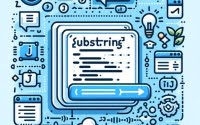Bootstrap and Node.js | NPM Installation Guide

Integrating Bootstrap into your project can be done with a simple npm command. Utilizing it makes creating responsive and visual web applications a breeze. Today’s guide will walk you through the process of installing Bootstrap with npm, for use in your Node.js projects.
When developing software for IOFLOOD, we prefer to integrate Bootstrap with npm for additional UI/UX support and simplified development. By gathering our tips and standarized processes we’ve put together this guide to help our bare metal server customers that wish to utilize Bootstrap in their Node.js Servers.
This guide will walk you through the process of using npm to install Bootstrap, ensuring you have access to its extensive features for building responsive, mobile-first sites. Whether you’re starting a new project or looking to enhance an existing one, Bootstrap’s library of styles and components can significantly streamline your development process.
Let’s dive in and elevate your web development game by mastering Bootstrap installation with npm!
TL;DR: How Do I Install Bootstrap with npm?
You can install Bootstrap by running the npm command
npm install bootstrapin your project directory. Once installed, you can import Bootstrap stylesheets into your project’s JavaScript or CSS files as needed.
Here’s an example
npm install bootstrap
# Output:
# 'bootstrap' and its dependencies have been added to your project.
This command installs Bootstrap into your project, making it ready for use. With Bootstrap, you’re unlocking a treasure trove of responsive, mobile-first design components that will elevate your web projects to the next level. Whether you’re building a personal blog or a complex web application, Bootstrap’s comprehensive library of styles and components is designed to help you create visually appealing, highly functional websites with minimal effort.
Excited to dive deeper? Keep reading for detailed installation instructions, usage examples, and tips for integrating Bootstrap with your projects.
Table of Contents
The Basics: Install Bootstrap with npm
When you’re just getting started with web development, the world of npm and Bootstrap can seem a bit daunting. However, it’s actually quite straightforward once you get the hang of it. This section will provide a beginner-friendly, step-by-step guide to installing Bootstrap using npm, setting up your project accordingly, and including Bootstrap in your HTML files.
Step 1: Initialize Your Project
Before installing Bootstrap, you need to have npm and Node.js installed on your computer. If you haven’t done so, visit the official Node.js website to download and install the latest version. Once installed, you can initialize your project by running the following command in your project directory:
npm init -y
# Output:
# This will create a 'package.json' file in your project directory.
This command creates a package.json file in your project directory, which will manage all the dependencies for your project, including Bootstrap.
Step 2: Install Bootstrap
Now that your project is initialized, you can install Bootstrap by running:
npm install bootstrap
# Output:
# 'bootstrap' and its dependencies are now in your 'node_modules' folder.
This command downloads Bootstrap and its dependencies into your project’s node_modules folder, making it ready for use.
Step 3: Include Bootstrap in Your HTML
After installing Bootstrap, you need to include it in your HTML files to start using its components and styles. Here’s a simple example of how to include Bootstrap’s CSS in your HTML file:
<!DOCTYPE html>
<html>
<head>
<link rel="stylesheet" href="node_modules/bootstrap/dist/css/bootstrap.min.css">
</head>
<body>
<!-- Your content goes here -->
</body>
</html>
By including the link to Bootstrap’s CSS file in your HTML’s “ section, you make all of Bootstrap’s styles available to your project. This enables you to use Bootstrap’s vast component library to build responsive, mobile-first sites.
Pros: Quick setup, access to Bootstrap’s vast component library.
Cons: Requires basic knowledge of npm and project setup.
By following these simple steps, you can easily integrate Bootstrap into your projects, enhancing your web development journey with its extensive features.
Customizing Bootstrap with npm
After mastering the basics of integrating Bootstrap into your projects using npm, you might find yourself wanting more control over the look and feel of your site. This is where advanced features of Bootstrap, such as theme customization and selective component import, come into play. By taking advantage of npm’s capabilities, you can tailor Bootstrap to fit your project’s unique requirements.
Customizing Themes
Bootstrap’s default theme is designed to be both appealing and versatile, but there may be scenarios where you want to modify it to better align with your brand or design vision. This can be achieved by customizing Bootstrap’s Sass variables. First, ensure you have Sass installed in your project:
npm install sass
# Output:
# 'sass' and its dependencies have been added to your project.
This command installs Sass, allowing you to compile Sass files into CSS. With Sass installed, you can now override Bootstrap’s default variables before including Bootstrap in your project.
Importing Specific Components
One of the strengths of using npm to manage Bootstrap is the ability to import only the components you need, leading to a more efficient loading time. For example, if you only need the modal component, you can import it into your JavaScript file like so:
import 'bootstrap/js/dist/modal';
This code snippet demonstrates how to import a specific Bootstrap component using JavaScript modules. By doing this, you’re not only optimizing your project’s loading time but also keeping your codebase clean and focused on the components you actually use.
Pros:
– Efficient loading by importing only necessary components.
– Customization capabilities through Sass for a unique look.
Cons:
– Requires understanding of JavaScript modules and Sass.
By exploring these advanced features, you unlock the full potential of Bootstrap, making your projects not just functional but also uniquely yours. Whether it’s tweaking the aesthetic details or optimizing the load time, npm and Bootstrap together provide a powerful toolkit for any web developer looking to elevate their sites.
Alternative Ways to Use Bootstrap
While the npm command npm install bootstrap is a straightforward way to integrate Bootstrap into your projects, there are alternative methods worth considering, especially for expert-level developers seeking different approaches for specific scenarios. Understanding when to use npm versus other options like CDN links or direct downloads can greatly influence your project’s speed, customization capabilities, and overall management.
Using CDN Links
One popular alternative is to use Bootstrap’s CDN (Content Delivery Network) links. This method allows you to include Bootstrap’s CSS and JavaScript files directly into your HTML without installing anything locally. Here’s how you can include Bootstrap via CDN:
<link rel="stylesheet" href="https://stackpath.bootstrapcdn.com/bootstrap/4.3.1/css/bootstrap.min.css">
<script src="https://stackpath.bootstrapcdn.com/bootstrap/4.3.1/js/bootstrap.min.js"></script>
Using CDN links is incredibly fast and convenient, especially for small projects or prototypes where you want to get up and running quickly. However, it offers less customization and can be slower in loading times due to reliance on external servers.
Direct Downloads
Another method is directly downloading Bootstrap files and including them in your project. This approach gives you full control over the Bootstrap files, allowing for customization before adding them to your project. To download Bootstrap, visit the official Bootstrap website, download the compiled CSS and JS files, and include them in your project.
While direct downloads offer maximum control and customization, they require manual updates and can complicate project management compared to using npm.
NPM: The Preferred Method
Despite these alternatives, using npm remains the preferred method for several reasons:
- Speed: npm allows for quick installation and updates.
- Customization: By installing Bootstrap through npm, you gain access to its Sass files, enabling deep customization.
- Project Management: npm keeps track of versions and dependencies, simplifying project maintenance.
In summary, while CDN links and direct downloads offer their own advantages, npm stands out for its balance of speed, customization, and ease of project management. Choosing the right method depends on your project’s needs, but npm’s versatility often makes it the go-to choice for integrating Bootstrap.
Troubleshooting Bootstrap Installs
Even with the simplicity of installing Bootstrap using npm, you might encounter some hiccups along the way. Let’s tackle common issues such as version conflicts or installation errors, and arm you with solutions and workarounds to ensure a smooth Bootstrap experience.
Handling Version Conflicts
One of the more common challenges when working with npm is managing version conflicts, especially when your project depends on multiple packages that require different versions of Bootstrap.
To check the current version of Bootstrap installed in your project, you can run:
npm list bootstrap
# Output:
# [email protected]
This command lists the version of Bootstrap that’s currently installed. If you encounter a version conflict, consider using npm’s package.json to specify the exact version of Bootstrap your project needs. For example:
"dependencies": {
"bootstrap": "^4.3.1"
}
Resolving Installation Errors
Installation errors can occur for a variety of reasons, from network issues to permissions problems. If you encounter an error while trying to install Bootstrap using npm, first ensure that your network connection is stable. If the issue persists, you may need to clear npm’s cache:
npm cache clean --force
# Output:
# Cache cleaned.
This command forces npm to clear its cache, potentially resolving any corrupt cache issues that might be causing installation problems.
Optimizing Your Bootstrap Experience
To optimize your Bootstrap experience, consider leveraging npm’s capabilities to manage your project’s dependencies efficiently. Regularly update your dependencies to keep your project secure and take advantage of the latest features. Use npm’s update command to easily update Bootstrap to the latest version:
npm update bootstrap
# Output:
# Updated bootstrap to latest version.
This command updates Bootstrap to the latest version, ensuring you have access to the newest features and security patches.
By understanding these common issues and how to address them, you can ensure a more reliable and efficient workflow when integrating Bootstrap into your projects using npm.
Understanding npm and Bootstrap
Before diving into the specifics of integrating Bootstrap with npm, let’s lay the groundwork by understanding what npm and Bootstrap are, and why they are pivotal in modern web development.
npm: The Heart of Node.js
npm, short for Node Package Manager, is the default package manager for the JavaScript runtime environment Node.js. It is a powerful tool that allows developers to install, share, and manage dependencies (libraries and packages) in their projects.
npm init -y
# Output:
# package.json created
The command npm init -y quickly sets up a new Node.js project by creating a package.json file. This file tracks your project’s dependencies and their versions, ensuring consistency and ease of installation across different environments. The -y flag automatically fills in default values, streamlining the setup process.
Bootstrap: Designing with Ease
Bootstrap, on the other hand, is a free and open-source CSS framework directed at responsive, mobile-first front-end web development. It contains CSS- and JavaScript-based design templates for typography, forms, buttons, navigation, and other interface components.
By integrating Bootstrap into your projects, you’re not just adopting a style sheet; you’re embracing a comprehensive design system that accelerates development and ensures consistency across devices.
The Synergy of npm and Bootstrap
Using npm to manage Bootstrap as a dependency in your projects offers several benefits:
- Simplicity: Installing Bootstrap is as simple as running a single npm command.
- Version Control: Easily manage which version of Bootstrap your project uses, and update it seamlessly via npm.
- Customization: Access to Bootstrap’s source files allows for deep customization, especially when using Sass.
In essence, the combination of npm and Bootstrap equips developers with a robust set of tools to efficiently build and maintain visually appealing, responsive websites. Understanding these fundamentals sets the stage for a successful integration of Bootstrap into your web projects, leveraging npm’s capabilities to the fullest.
Additional Bootstrap Tools
While Bootstrap provides a solid foundation for responsive and mobile-first web design, the journey doesn’t end there. The broader ecosystem of tools and libraries, such as jQuery and Popper.js, can further enhance your Bootstrap projects. Let’s explore how these complementary tools can be integrated and why they might be beneficial for your projects.
Integrating jQuery with Bootstrap
Bootstrap’s JavaScript plugins were historically dependent on jQuery for functionality. While Bootstrap 5 has moved away from this dependency, understanding how to integrate jQuery can be beneficial for projects using older versions or for those who prefer jQuery’s syntax and features.
import $ from 'jquery';
import 'bootstrap';
$(document).ready(function() {
$('.alert').alert();
});
# Output:
# Initializes Bootstrap's alert component using jQuery.
In this example, jQuery is used to initialize Bootstrap’s alert component upon document ready. This illustrates how jQuery can be seamlessly integrated with Bootstrap, enabling you to leverage both libraries’ strengths.
Utilizing Popper.js for Tooltips
Popper.js is a library used by Bootstrap for positioning tooltips and popovers effectively. Integrating Popper.js directly can offer more control over these elements’ behavior and positioning.
import { createPopper } from '@popperjs/core';
const popperInstance = createPopper(referenceElement, popperElement);
# Output:
# Creates a new Popper.js instance for managing tooltips or popovers.
By directly using Popper.js, developers gain finer control over the positioning and behavior of tooltips and popovers, beyond what Bootstrap’s default settings offer.
Further Resources for Bootstrap Enhancement
To dive deeper into the world of Bootstrap and its complementary tools, here are three valuable resources:
- Official Bootstrap Documentation offers comprehensive guides and examples for using Bootstrap and integrating with other libraries.
Learn jQuery provides tutorials and articles for mastering jQuery, a useful skill for enhancing Bootstrap projects.
Popper.js Official Documentation is the go-to resource for understanding and using Popper.js in your web projects.
These resources offer a wealth of information for developers looking to expand their knowledge and capabilities with Bootstrap, jQuery, and Popper.js, ensuring you can build even more dynamic and responsive web applications.
Wrapping Up: Bootstrap and npm
In this comprehensive guide, we’ve navigated the process of installing and using Bootstrap with npm, illuminating a path from the initial setup to advanced customization. Bootstrap’s role in modern web development is undeniably pivotal, offering a vast library of styles and components that cater to responsive, mobile-first designs. npm, on the other hand, streamlines the management of such dependencies, ensuring that projects remain up-to-date and secure.
We began with the basics, showing you how to seamlessly integrate Bootstrap into your projects with a simple npm command. We then ventured into more sophisticated territory, demonstrating how to customize Bootstrap themes and selectively import components to optimize your project’s performance.
Along the way, we tackled common challenges, such as version conflicts and installation errors, providing you with solutions and workarounds to keep your development process smooth. We also explored alternative methods for using Bootstrap, weighing the pros and cons of each approach to help you make informed decisions based on your project’s needs.
| Approach | Pros | Cons |
|---|---|---|
| npm | Customization, version control | Initial setup required |
| CDN | Quick setup, no installation | Limited customization, external dependency |
| Direct Download | Full control, offline access | Manual updates, more complex setup |
Whether you’re just starting out with Bootstrap or looking to refine your existing knowledge, we hope this guide has provided you with valuable insights into using Bootstrap with npm to create responsive, visually appealing websites. The combination of npm and Bootstrap not only simplifies the development process but also opens up a world of possibilities for customization and optimization.
With the tools and techniques discussed, you’re well-equipped to take your web projects to the next level. Happy coding!


